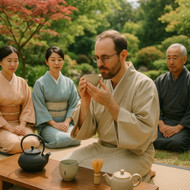Japanese Tea: History, Culture, and the Most Celebrated Varieties
Japan’s tea culture is among the world’s most refined, blending centuries-old tradition with a remarkable diversity of flavors and styles. While tea originally arrived from China, it has become an integral part of Japanese daily life and ceremony, with green tea (ocha, お茶) at its heart ([2], [4]).
Historical Roots of Japanese Tea
Tea was first brought to Japan from China during the Heian period (794–1185 AD) by Buddhist monks such as Saichō and Kūkai, who used it as a stimulant for meditation ([2], [4]). In the 12th century, Zen master Eisai introduced new tea seeds and the powdered preparation method, laying the foundation for the Japanese tea ceremony and spreading green tea among the aristocracy and, eventually, the wider population ([3]). Over the centuries, tea became a symbol of hospitality, mindfulness, and social connection in Japan.
Japanese Tea Culture Today
Tea remains deeply embedded in Japanese culture, offered to guests in both private and business settings, and enjoyed casually or as part of the formal tea ceremony (chanoyu) ([2]). While traditional tea rituals are still practiced, especially among enthusiasts and in cultural contexts, modern Japan also embraces ready-to-drink teas and innovative tea products, reflecting a blend of old and new.
The Main Types of Japanese Tea
Japan produces over 20 distinct types of tea, most of which are green teas processed by steaming, rolling, and drying the leaves ([6]). Here are some of the most popular and celebrated varieties:
- Sencha: The most widely consumed tea in Japan, making up about 70% of domestic tea consumption. Sencha is steamed, rolled, and dried, resulting in a fresh, grassy flavor with a balance of sweetness and astringency ([5], [7], [4]).
- Matcha: Finely ground powdered green tea, traditionally used in the Japanese tea ceremony. Matcha is known for its vibrant color, rich umami flavor, and energizing properties. It is also popular in modern sweets and beverages ([1], [5]).
- Gyokuro: Considered one of Japan’s finest teas, Gyokuro is shade-grown for several weeks before harvest, increasing its chlorophyll and theanine content. This produces a sweet, savory, and intensely aromatic tea, often reserved for special occasions ([4], [7]).
- Genmaicha: A blend of green tea (often Sencha or Bancha) with roasted brown rice, giving it a nutty, toasty flavor and a lower caffeine content ([5]).
- Hojicha: Made by roasting green tea leaves (usually Bancha or Sencha), Hojicha has a reddish-brown color, a toasty aroma, and a mild, low-caffeine profile ([5], [7]).
- Kukicha: Also known as twig tea, Kukicha is made from the stems and twigs of the tea plant, resulting in a light, sweet, and low-caffeine tea ([5]).
- Bancha: Harvested later in the season than Sencha, Bancha has larger, thicker leaves and a more robust, grassy flavor ([7]).
- Shincha: The first flush of Sencha harvested in spring, Shincha is prized for its fresh, delicate flavor and limited availability ([7]).
- Kabusecha: Similar to Gyokuro, Kabusecha is partially shade-grown, resulting in a tea with a balance of sweetness and astringency ([7]).
- Tencha: The unground leaf used to make Matcha, Tencha is rarely brewed as a tea but is essential in Matcha production ([7]).
- Kamairicha: Pan-fired rather than steamed, Kamairicha has a slightly roasted, nutty flavor reminiscent of some Chinese green teas ([7]).
- Kocha: Japanese black tea, less common than green tea but gaining popularity for its unique character ([7]).
- Sakura-cha: A festive tea made from cherry blossoms, enjoyed for its floral aroma and symbolism in springtime celebrations ([7]).
Brewing and Enjoyment
Each type of Japanese tea has its own ideal brewing temperature and steeping time to bring out its best qualities. For example, Sencha is typically brewed at 70–80°C (158–176°F) for about one minute, while Matcha is whisked with hot water to create a frothy, vibrant drink ([3]). Cold brew and ice brew methods are also popular, especially in summer, producing a milder, sweeter cup.
Japanese Tea in Modern Life
While the formal tea ceremony remains a cultural treasure, most Japanese people enjoy tea in simpler forms-at home, in restaurants, or from vending machines. Ready-to-drink teas and tea-based snacks are widespread, and specialty tea houses continue to introduce new generations to the pleasures of Japanese tea ([2], [7]).
Health Benefits and Global Influence
Japanese green teas are celebrated for their health benefits, including antioxidants, vitamins, and amino acids that may support heart health, metabolism, and mental clarity ([8]). The global popularity of Matcha, Sencha, and other Japanese teas has influenced beverage trends, culinary recipes, and wellness movements worldwide.
Conclusion
Japanese tea is a living tradition, evolving from its ancient origins to its modern expressions. Whether enjoyed in a tranquil tea ceremony or as a refreshing drink on the go, Japanese tea offers a journey through history, culture, and extraordinary flavor.
References
- Japanese Tea Varieties - Sugimoto Tea Company
- Tea culture in Japan - The tradition at a glance - Matcha-Karu
- History of the Japanese Tea Ceremony - Chado Tea
- Discovering Japanese Green Tea: Types & Flavors
- Different Types of Japanese Tea: A Beginner's Guide - byFood
- Types of Japanese Tea - Tezumi
- Japanese Green Teas: A Comprehensive Guide - ArtfulTea
- The History of Japanese Tea | Blog - The Tea Makers of London
- Exploring the Rich History and Culture of Japanese Tea - Momoca
- Japanese Tea Brewing - GJTea

